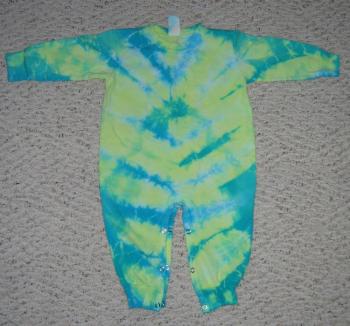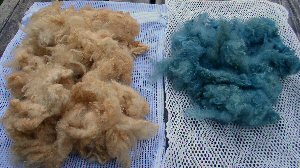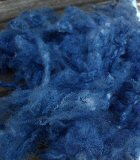
More pictures can be found at badmom.
Category: Dye Page 13 of 14
When I first started spinning 2.5 years ago, I never realized all the different paths that this fiber pursuit would take me down, and all the wonderful people that I would meet along the way. I’m not talking just in the blog world, but the wonderful people I’ve met in various guilds that I’ve joined and the people I met at various shows and conferences. The fiber world has got to have some of the most diverse and interesting people I’ve ever met. The enthusiasm and the willingness to help a fellow fiber artist is absolutely amazing.
By the way, I found Norma’s blog entry today to be a great read. And she is right on with her observations.
I started this blog as a way of keeping track of my projects and experiments. I never envisioned that it would actually be read by anyone. In fact, I’ve gone out of the way to maintain some level of anonymity. (Have you ever wondered by you can’t find this site on Google? robots.txt is a good thing.) It’s not that I want to keep people out, I just don’t want people to have easy access. Sounds like I’m antisocial, doesn’t it? And in 2 years, I’ve never bothered to remove the robots.txt file.
Anyway, that’s a long way around to today’s entry. When I started spinning, I promised myself and Martin that (a) I did not intend to card my own fiber, thus would not need a drum carder, (b) I would never buy combs, (c) I don’t plan on dyeing my own fiber, and (d) I don’t intend to buy/process raw fleece.
Cough. Cough. Mumble. Um. Yeah. I did all the above. And some. And I didn’t intend to own more than one spinning wheel either.
Alright, what does all that have to do with the second part of today’s title? Well, dyeing is one of the paths that I took along the way. And I have to say, I love it. First, I love color. I’m fairly conservative when it comes to knitting with color, but I love color. And I love spinning a beautifully dyed roving. So, of course, I decided that I have to try my hand at dyeing. And I love it. And I love the variability and surprises that come with dyeing.
Please note. I will never be a threat to the professionals out there that sell their hand painted yarns and rovings. I bow to their sense of color and their ability to reproduce their color ways time and time again.
I can buy those. I dye because I enjoy creating something out of nothing. And often, I have absolutely no idea what I’m going to get at the end of the process. I like surprises. It’s like a little present to myself. Besides, if you have no expectations, you can’t be disappointed.
It is for this reason that I enjoy playing with natural dyes. Something from nothing (see apple prunings entry earlier this month). A surprise every time.
Chemical dyes are formulated to have predictable results every single time. And the colors are absolutely fabulous and vibrant. And, to me, instant gratification.
Natural dyes have quite a bit more variability. Change just a little variable, you’ll get a completely different result. Change the mordant, you get a lighter or a darker color. Change the pot you use. Change the temperature. Use a pre-mordant, mordant in the dye bath, or apply mordant after the dye bath, and you get different results. Infinite possibilities.
 (Click on the thumbnails for larger pictures.) These silk rovings from Pastiche are excellent examples of variability in natural dyeing. As I mentioned in my original entry, it has beautiful blues, greens, amber, lavenders in the grey. Even though the dyer knew exactly what combination of natural dyes were used in producing this, she was never able to reproduce it again. It was just one of those things. (These 2 rovings were in the same dye bath, which is why they are similar.)
(Click on the thumbnails for larger pictures.) These silk rovings from Pastiche are excellent examples of variability in natural dyeing. As I mentioned in my original entry, it has beautiful blues, greens, amber, lavenders in the grey. Even though the dyer knew exactly what combination of natural dyes were used in producing this, she was never able to reproduce it again. It was just one of those things. (These 2 rovings were in the same dye bath, which is why they are similar.)
However, there is good news for the average natural dyers who wants to be able to reproduce a color way, time and time again. Michele Wipplinger has created a line of natural dyes called Earthues. They come with instructions and recipes for creating reproducible colors.
The color palette with natural dyes are more limited than with chemical dyes. For example, I have never seen a true green. You get can get yellow greens if you use iron. You can get blue greens if you overdye with indigo. But not a scream in your face Oregon Ducks green, never mind the neon lime green. What you get are more earthy colors.
It’s not good nor bad, just different.
With my amateur status and my slap dash ways, I will never get the exact colors. But I am happy with what I get. (If you are one of those people that really like precision, you can get reproducible colors with natural dyes. I’m just not that person.)
And playing with natural dyes has opened a whole new world for me. Walks around the neighborhood, office park, or hikes in the forests are now walks that are filled with possibilities. I wonder what color that tree/flower/nut/lichen will make?
I played with some natural dyes this weekend.

I dyed some wool in that dye bath made with apple leaves and twigs. Then I overdyed a small portion of that with an indigo bath that’s been sitting around. It was a really, really short dip (less than 2 minutes total), but the blue really took, and it’s a blue-green, and I was hoping for more green. But, I started out with a light brown to start with, so it’s probably not too surprising. I did this dye sample without mordants, since I read that it was not necessary, but I will try another batch with an alum mordant. Stay tuned.
 Here’s a handful of wool that I let sit in the indigo bath for about 30 minutes after an initial dip of 5 minutes (aired out for 10 minutes in between). I did this batch to make sure that the indigo bath could be revived and still usable, since it’s been sitting out on the back deck for 9 months or so. Yikes! But with a little Rit dye remover, it was good as new. And as you can see from the apple sample, still pretty dang potent! There are a few small white patches because I didn’t really let the wool soak long enough (a 5-10 minute presoak because I was so darned impatient to see what was happening with the indigo).
Here’s a handful of wool that I let sit in the indigo bath for about 30 minutes after an initial dip of 5 minutes (aired out for 10 minutes in between). I did this batch to make sure that the indigo bath could be revived and still usable, since it’s been sitting out on the back deck for 9 months or so. Yikes! But with a little Rit dye remover, it was good as new. And as you can see from the apple sample, still pretty dang potent! There are a few small white patches because I didn’t really let the wool soak long enough (a 5-10 minute presoak because I was so darned impatient to see what was happening with the indigo).
I have some lincoln-corriedale locks that are soaking in alum right now. I want to try the cutch again, with the fiber pre-mordanted, instead of the alum in the dye bath to see what the difference is.
It’s slow going, changing only one variable at a time. But once I get what I want, then I’ll do a full dye batch.
What am I looking for, you ask? I want a reddish brown and a light green. Anyone know of a sure fire recipe?
